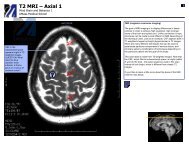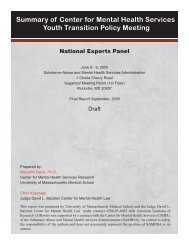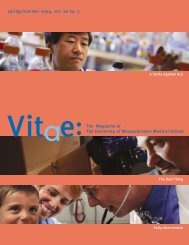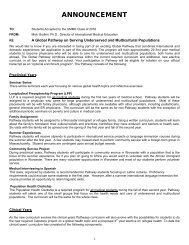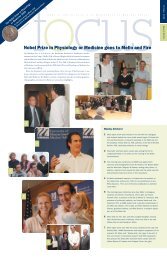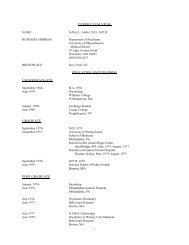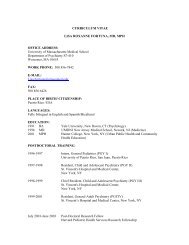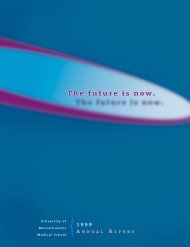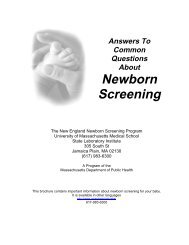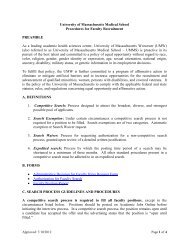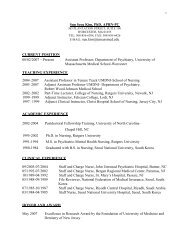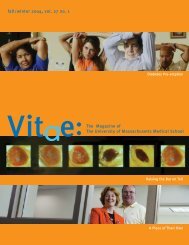Annual Report 2001 - the University of Massachusetts Medical School
Annual Report 2001 - the University of Massachusetts Medical School
Annual Report 2001 - the University of Massachusetts Medical School
You also want an ePaper? Increase the reach of your titles
YUMPU automatically turns print PDFs into web optimized ePapers that Google loves.
Jean A. King, PhD, associate pr<strong>of</strong>essor <strong>of</strong> psychiatry: Predicting Early Risk For Depression with Functional Magnetic<br />
Resonance Imaging. Dr. King is using <strong>the</strong> sophisticated FMRI technology, which can measure <strong>the</strong> actual biochemical<br />
status <strong>of</strong> cells, particularly <strong>the</strong>ir metabolic level and state <strong>of</strong> intercellular signaling, to develop a<br />
database <strong>of</strong> brain images in a prospective study <strong>of</strong> <strong>the</strong> onset <strong>of</strong> depression. By linking <strong>the</strong> image database<br />
with <strong>the</strong> subsequent onset <strong>of</strong> disease, it is hoped that early signposts will be identified that will be highly reliable<br />
for anticipating depressive illness.<br />
Kendall L. Knight, PhD, associate pr<strong>of</strong>essor <strong>of</strong> biochemistry & molecular pharmacology: Defining <strong>the</strong> Role <strong>of</strong><br />
<strong>the</strong> Rad52 Protein in Maintaining <strong>the</strong> Functional Integrity <strong>of</strong> <strong>the</strong> Human Genome. The cells <strong>of</strong> <strong>the</strong> body have a<br />
remarkable capacity for repairing damage to <strong>the</strong>ir DNA. Dr. Knight has been working on a component <strong>of</strong><br />
<strong>the</strong> DNA repair equipment <strong>of</strong> cells, a protein called Rad52 (HsRad52), to determine how this protein collaborates<br />
with <strong>the</strong> rest <strong>of</strong> <strong>the</strong> DNA repair machinery, with <strong>the</strong> goal <strong>of</strong> developing a deeper understanding <strong>of</strong><br />
this crucial process.<br />
James F. Paskavitz, MD, assistant pr<strong>of</strong>essor <strong>of</strong> neurology: Functional MRI <strong>of</strong> Executive Cognitive Dysfunction in<br />
Multiple Sclerosis. Dr. Paskavitz is applying <strong>the</strong> powerful method <strong>of</strong> FMRI to develop a database <strong>of</strong> patient<br />
images, through which it will be possible to identify both <strong>the</strong> most prevalent sites <strong>of</strong> brain alterations associated<br />
with MS, as well as <strong>the</strong> degree <strong>of</strong> patient-to-patient variation. The results <strong>of</strong> this project may <strong>of</strong>fer <strong>the</strong><br />
managing physician a deeper base <strong>of</strong> information on <strong>the</strong> patient, as well as help <strong>the</strong> family understand<br />
and cope with behavioral changes.<br />
Thoru Pederson, PhD, pr<strong>of</strong>essor <strong>of</strong> biochemistry & molecular pharmacology and <strong>the</strong> Vitold Arnett Pr<strong>of</strong>essor<br />
<strong>of</strong> Cell Biology: Hormone Regulation <strong>of</strong> a Gene Implicated in Human Aging and <strong>of</strong> Relevance to Stem Cell<br />
Therapeutics.This research is aimed at finding better ways to control <strong>the</strong> production in cells <strong>of</strong> an enzyme<br />
called telomerase, which builds and maintains special protective structures at <strong>the</strong> two ends <strong>of</strong> each chromosome<br />
(DNA). The project is designed to test a novel idea for inducing cells to make higher levels <strong>of</strong> telomerase<br />
in certain biological situations, potentially including stem cell <strong>the</strong>rapeutics.<br />
German A. Pihan, MD, assistant pr<strong>of</strong>essor <strong>of</strong> pathology: Biology and Genetics <strong>of</strong> <strong>the</strong> Reed-Sternberg Cell in<br />
Hodgkin’s Disease. Dr. Pihan’s research focuses on discovering <strong>the</strong> molecular basis <strong>of</strong> <strong>the</strong> genesis <strong>of</strong> <strong>the</strong><br />
Reed-Sternberg (RS) cell, <strong>the</strong> malignant cell in Hodgkin’s lymphoma. Using a combination <strong>of</strong> in vivo<br />
microscopy and complementation cloning techniques, he is investigating <strong>the</strong> mechanism that determines<br />
how <strong>the</strong>se cells become multinucleated, which will ultimately lead to more effective and selective drugs<br />
against <strong>the</strong> disease.<br />
Lawrence D. Recht, MD, pr<strong>of</strong>essor <strong>of</strong> neurology and surgery: A Feasibility Test <strong>of</strong> Stem Cell Therapies. As it<br />
has been very difficult to compare <strong>the</strong> potential <strong>of</strong> stem cells to incorporate into tissues and repair defects,<br />
Dr. Recht has developed a novel assay system in which such cells, harvested from various tissues and ages,<br />
can be incorporated into blastocysts, early embryos that have not yet begun to differentiate.With this system,<br />
he anticipates <strong>the</strong> ability to accurately assess <strong>the</strong>se cell types for <strong>the</strong>ir potential use in clinical <strong>the</strong>rapeutics.<br />
Maria L. Zapp, PhD, assistant pr<strong>of</strong>essor <strong>of</strong> molecular genetics & microbiology: Development <strong>of</strong> Novel Assay Systems<br />
to Study HCV Replication. With an interest in cellular and viral gene expression, Dr. Zapp is investigating <strong>the</strong><br />
mechanism <strong>of</strong> hepatitis C virus replication. Despite <strong>the</strong> availability <strong>of</strong> HCV cDNAs, <strong>the</strong>re is no efficient,<br />
reproducible in vitro system for studying HCV replication. Dr. Zapp’s project is aimed at developing such a system.<br />
19





